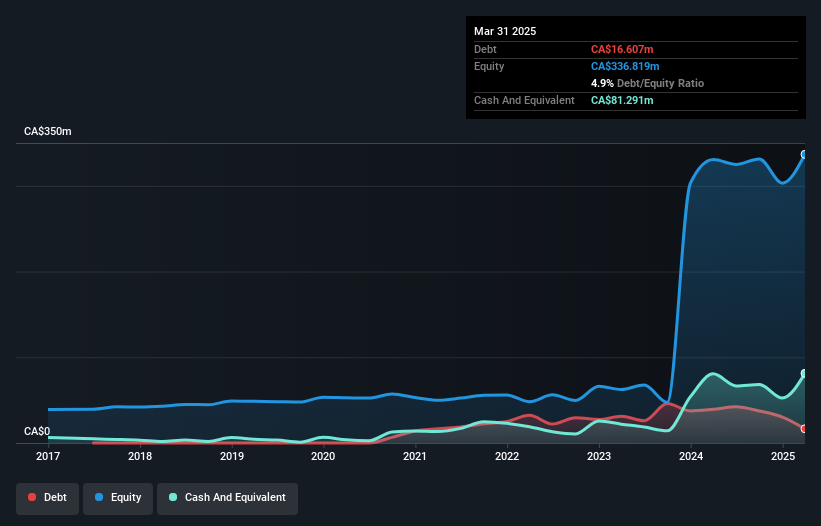Some say volatility, rather than debt, is the best way to think about risk as an investor, but Warren Buffett famously said that 'Volatility is far from synonymous with risk.' When we think about how risky a company is, we always like to look at its use of debt, since debt overload can lead to ruin. As with many other companies IsoEnergy Ltd. (TSE:ISO) makes use of debt. But is this debt a concern to shareholders?
Our free stock report includes 2 warning signs investors should be aware of before investing in IsoEnergy. Read for free now.Why Does Debt Bring Risk?
Debt assists a business until the business has trouble paying it off, either with new capital or with free cash flow. Ultimately, if the company can't fulfill its legal obligations to repay debt, shareholders could walk away with nothing. However, a more common (but still painful) scenario is that it has to raise new equity capital at a low price, thus permanently diluting shareholders. Of course, debt can be an important tool in businesses, particularly capital heavy businesses. When we examine debt levels, we first consider both cash and debt levels, together.
What Is IsoEnergy's Debt?
You can click the graphic below for the historical numbers, but it shows that IsoEnergy had CA$16.6m of debt in March 2025, down from CA$39.4m, one year before. However, its balance sheet shows it holds CA$81.3m in cash, so it actually has CA$64.7m net cash.

A Look At IsoEnergy's Liabilities
According to the last reported balance sheet, IsoEnergy had liabilities of CA$29.5m due within 12 months, and liabilities of CA$2.72m due beyond 12 months. Offsetting this, it had CA$81.3m in cash and CA$492.3k in receivables that were due within 12 months. So it actually has CA$49.6m more liquid assets than total liabilities.
This surplus suggests that IsoEnergy has a conservative balance sheet, and could probably eliminate its debt without much difficulty. Simply put, the fact that IsoEnergy has more cash than debt is arguably a good indication that it can manage its debt safely. The balance sheet is clearly the area to focus on when you are analysing debt. But it is future earnings, more than anything, that will determine IsoEnergy's ability to maintain a healthy balance sheet going forward. So if you want to see what the professionals think, you might find this free report on analyst profit forecasts to be interesting.
Check out our latest analysis for IsoEnergy
Since IsoEnergy doesn't have significant operating revenue, shareholders must hope it'll sell some fossil fuels, before it runs out of money.
So How Risky Is IsoEnergy?
We have no doubt that loss making companies are, in general, riskier than profitable ones. And in the last year IsoEnergy had an earnings before interest and tax (EBIT) loss, truth be told. Indeed, in that time it burnt through CA$34m of cash and made a loss of CA$32m. But at least it has CA$64.7m on the balance sheet to spend on growth, near-term. Even though its balance sheet seems sufficiently liquid, debt always makes us a little nervous if a company doesn't produce free cash flow regularly. There's no doubt that we learn most about debt from the balance sheet. But ultimately, every company can contain risks that exist outside of the balance sheet. Case in point: We've spotted 2 warning signs for IsoEnergy you should be aware of, and 1 of them doesn't sit too well with us.
If you're interested in investing in businesses that can grow profits without the burden of debt, then check out this free list of growing businesses that have net cash on the balance sheet.
New: AI Stock Screener & Alerts
Our new AI Stock Screener scans the market every day to uncover opportunities.
• Dividend Powerhouses (3%+ Yield)
• Undervalued Small Caps with Insider Buying
• High growth Tech and AI Companies
Or build your own from over 50 metrics.
Have feedback on this article? Concerned about the content? Get in touch with us directly. Alternatively, email editorial-team (at) simplywallst.com.
This article by Simply Wall St is general in nature. We provide commentary based on historical data and analyst forecasts only using an unbiased methodology and our articles are not intended to be financial advice. It does not constitute a recommendation to buy or sell any stock, and does not take account of your objectives, or your financial situation. We aim to bring you long-term focused analysis driven by fundamental data. Note that our analysis may not factor in the latest price-sensitive company announcements or qualitative material. Simply Wall St has no position in any stocks mentioned.
About TSX:ISO
IsoEnergy
Engages in the acquisition, development, and exploration of uranium mineral properties in Canada, the United States, and Australia.
Excellent balance sheet with slight risk.
Similar Companies
Market Insights
Weekly Picks

Solutions by stc: 34% Upside in Saudi's Digital Transformation Leader


The AI Infrastructure Giant Grows Into Its Valuation
Recently Updated Narratives
Many trends acting at the same time


Engineered for Stability. Positioned for Growth.


Staggered by dilution; positions for growth
Popular Narratives


MicroVision will explode future revenue by 380.37% with a vision towards success


NVDA: Expanding AI Demand Will Drive Major Data Center Investments Through 2026



